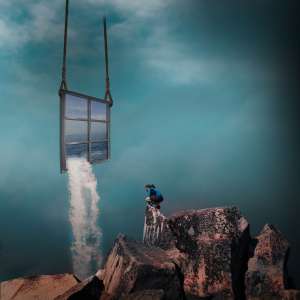Creative photo manipulation involves using photo editing software to alter or enhance a photograph in a way that goes beyond basic adjustments like color correction or cropping. It can involve combining multiple images, adding or removing elements, or using various effects and filters to create a new and unique image.
Here are some ideas for creative photo manipulation:
- Surreal landscapes: Take a landscape photo and add surreal elements like floating islands or impossible structures.
- Double exposure: Combine two or more photos to create a double exposure effect where one image overlaps or blends with another.
- Fantasy portraits: Use photo editing software to add fantasy elements like wings, horns, or magical powers to a portrait.
- Miniature world: Use a tilt-shift effect to make a real-life scene look like a miniature world.
- Animal hybrids: Combine two or more animal photos to create a hybrid creature that doesn’t exist in real life.
- Mirror image: Create a symmetrical image by duplicating and mirroring one side of a photo.
- Abstract patterns: Use filters and effects to create abstract patterns and textures from a photo.
- Vintage look: Use filters and effects to give a photo a vintage or retro look, like an old postcard or polaroid.
Remember to always respect creative photo manipulation copyright laws and to only use photos that you have the rights to use.
Famous photo manipulation artists
- Jerry Uelsmann – He is considered to be one of the pioneers of photomontage and is known for his surreal black and white images that often combine multiple negatives to create a single print.
- Erik Johansson – He is a Swedish photographer and artist who creates mind-bending images by combining photography, digital manipulation, and a lot of creativity. His work often plays with perspective and scale.
- Maggie Taylor – She is an American photographer and digital artist who creates dreamlike images using a combination of photography, scans of found objects, and digital manipulation. Her work often features whimsical characters and surreal landscapes.
- Brooke Shaden – She is an American photographer and artist who creates haunting and ethereal images that often feature solitary figures in mysterious or otherworldly landscapes. Her work is heavily influenced by fairy tales and mythology.
- Christophe Gilbert – He is a Belgian photographer and digital artist who creates surreal and often dark images that blend photography and digital manipulation. His work often features unexpected juxtapositions and macabre themes.
- Jeff Wall – He is a Canadian photographer and artist who creates large-scale photographs that blur the line between reality and fiction. His images often reference art history and challenge our perception of the world around us.
- Thomas Barbey – He is a Swiss photographer and artist who creates intricate and surreal photomontages by combining multiple negatives and photographs. His work often features architectural elements and plays with perspective and scale.
- John Heartfield – He was a German artist and pioneer of photomontage who used his work as a form of political commentary during the 1920s and 1930s. His powerful images often targeted Nazi propaganda and helped to shape the visual language of modern political satire.
How to photo manipulation
Photo manipulation involves altering or enhancing digital images using software tools like Adobe Photoshop, GIMP, or other photo editing software. Here are some general steps to perform photo manipulation:
- Select a photo to manipulate: Choose a photo that you want to edit and make sure it is in a digital format that can be edited.
- Choose your software: You can use Adobe Photoshop or other photo editing software to manipulate your image. There are also free options like GIMP and Pixlr.
- Familiarize yourself with the software: Take some time to learn the basics of the software you have chosen. You can watch tutorials, read manuals or take online courses to improve your skills.
- Plan your photo manipulation: Decide what you want to do with the photo. For example, do you want to remove an object, change the colors, add text or merge multiple photos?
- Open your image in the software: Once you have your software open, you can load your image by using the ‘open file’ command.
- Make adjustments: Start making adjustments to your image. You can use tools like cropping, resizing, and rotating to adjust the composition of the photo. You can also use filters, layers, and other tools to manipulate the image.
- Save your manipulated photo: Once you are satisfied with your photo, save it as a new file. You can also export it in various formats to suit your needs.
Remember, photo manipulation can take time to master. It’s important to be patient and experiment with different techniques to achieve the desired results.
 Is photo manipulation graphic design?
Is photo manipulation graphic design?
Photo manipulation can be considered a subset of graphic design, but it is not the entirety of it.
Graphic design encompasses a wide range of visual communication practices, including typography, branding, layout design, illustration, and more. Photo manipulation involves editing or altering existing photographs to achieve a desired result, which can be a component of graphic design.
However, graphic design involves creating visual content from scratch, and photo manipulation involves altering existing visual content. So, while photo manipulation can be a tool within the graphic design process, it is not the only or defining element of it.
Why photo manipulation is bad?
 Photo manipulation can be bad in certain contexts because it can deceive viewers by altering the reality of the image. In some cases, this manipulation can be harmless, such as adjusting the brightness or contrast of a photo to make it look better. However, when photo manipulation is used to deceive or mislead people, it can be harmful and unethical.
Photo manipulation can be bad in certain contexts because it can deceive viewers by altering the reality of the image. In some cases, this manipulation can be harmless, such as adjusting the brightness or contrast of a photo to make it look better. However, when photo manipulation is used to deceive or mislead people, it can be harmful and unethical.
For example, in news or documentary photography, manipulating images to change the meaning or context of a story can lead to misinformation and impact people’s perception of events. In advertising or fashion, manipulating photos of models to make them appear slimmer or more attractive can create unrealistic beauty standards that can harm people’s self-esteem and body image.
Furthermore, photo manipulation can be used to spread false information, propaganda, or even hate speech, which can have serious consequences for individuals and society as a whole. Therefore, it is important to use photo manipulation ethically and responsibly and to be transparent about any alterations made to an image.
When did photo manipulation start
 Photo manipulation, or the process of altering or enhancing photographs using various techniques, has been around since the early days of photography itself.
Photo manipulation, or the process of altering or enhancing photographs using various techniques, has been around since the early days of photography itself.
One of the earliest known examples of photo manipulation dates back to the mid-1800s, when a portrait photographer named Hippolyte Bayard created a self-portrait that appeared to show him as a drowned man. In reality, Bayard had not drowned, but had used a combination of multiple negatives and other techniques to create the illusion.
Another well-known example of early photo manipulation is the work of Oscar Gustave Rejlander, who created elaborate composite images by combining multiple negatives into a single photograph. Rejlander’s work was particularly influential in the development of the art of photography, and his techniques helped pave the way for later advancements in photo manipulation.
However, it was not until the advent of digital technology in the late 20th century that photo manipulation became widely accessible to the general public, as software like Adobe Photoshop made it easier than ever to manipulate and enhance photographs. Today, photo manipulation is a ubiquitous part of modern visual culture, and is used in everything from advertising and marketing to art and entertainment.
Creative photo manipulation
 Creative photo manipulation is the process of altering and enhancing photographs using various techniques and tools to create a desired artistic effect. This can involve combining multiple images, changing the colors or tones of an image, adding or removing objects, and applying various filters and effects.
Creative photo manipulation is the process of altering and enhancing photographs using various techniques and tools to create a desired artistic effect. This can involve combining multiple images, changing the colors or tones of an image, adding or removing objects, and applying various filters and effects.
Here are some tips and techniques for creating creative photo manipulations:
- Use multiple images: One of the easiest ways to create a unique and creative photo manipulation is to use multiple images. You can combine different elements from various images to create a surreal or abstract composition.
- Play with color: Adjusting the colors of your photo can create a completely different mood and atmosphere. You can use tools like hue, saturation, and contrast to enhance the colors of your image, or use selective coloring to highlight specific areas.
- Add textures: Adding textures can add depth and interest to your photo manipulation. You can overlay textures on your image, use brushes to add texture, or even create your own textures.
- Use filters and effects: Applying filters and effects can completely transform your photo. You can use filters to add a vintage or cinematic look to your image, or use effects like blur or distortion to create a surreal effect.
- Experiment with composition: Don’t be afraid to play with the composition of your photo. You can crop, flip, or rotate your image to create a more dynamic composition.
Remember, the key to creating creative photo manipulations is to experiment and have fun!
Creative Photo Manipulation: Unleashing Artistic Expression
Welcome to the realm of Creative Photo Manipulation, where artistry meets technology in a harmonious dance of visual storytelling. In this comprehensive guide, we’ll unravel the intricacies of this captivating practice, offering insights, tips, and inspiration to empower your artistic journey.
Exploring the Basics
Creative photo manipulation: A Fusion of Art and Technology Embark on a journey where imagination knows no bounds. Creative photo manipulation seamlessly blends artistic flair with technological prowess, allowing photographers to transcend the conventional and craft visual masterpieces.
Understanding the Core Elements Delve into the fundamental aspects of creative photo manipulation, exploring techniques like layering, blending, and masking. Uncover the magic behind transforming ordinary images into extraordinary works of art.
Techniques for Mastering Creative Photo Manipulation
Captivating Color Grading: Painting Emotions Explore the art of color grading to evoke emotions and enhance the narrative within your images. Learn how subtle shifts in color can create a powerful impact, transforming your photos into captivating visual stories.
Dimensional Depth: The Illusion of Reality Master the techniques of adding depth to your images, creating a three-dimensional illusion that captivates viewers. Discover how to strategically place elements within a composition to achieve a sense of realism and engagement.
Creative Fusion of Elements: Bringing Ideas to Life Unlock the secrets of seamlessly integrating diverse elements into your photographs. Whether it’s adding fantastical creatures or merging contrasting landscapes, learn how to bring your imaginative ideas to life through creative photo manipulation.
Pushing Boundaries: Advanced Techniques
Surreal Surrender: Embracing the Otherworldly Enter the realm of surrealism as we explore advanced techniques to push the boundaries of reality. From levitation to dreamlike landscapes, discover how to create awe-inspiring, otherworldly compositions that leave a lasting impact.
Invisible Mastery: Impeccable Object Removal Perfect your skills in removing unwanted objects from your images without leaving a trace. Explore advanced tools and techniques to achieve flawless results, maintaining the integrity of your visual narrative.
Creative Photo Manipulation in Practice
Real-world Applications: From Concept to Execution Witness the practical applications of creative photo manipulation across various industries. From advertising to digital art, understand how professionals leverage this art form to convey powerful messages and evoke emotions.
FAQs: Unveiling Insights
How can I start learning creative photo manipulation? Embark on your learning journey by exploring online tutorials, courses, and experimenting with basic techniques. Practice is key, so dedicate time to honing your skills and unleashing your creativity.
Are there legal considerations in using manipulated images? Yes, it’s crucial to respect copyright laws and usage rights. Ensure you have the right to use and manipulate images, especially if they are not your original creations.
Which software is best for creative photo manipulation? Adobe Photoshop stands out as the industry standard for creative photo manipulation. Its robust features and extensive toolset provide unparalleled flexibility for artists.
Can creative photo manipulation be used for ethical storytelling? Absolutely. When done responsibly, creative photo manipulation can enhance storytelling, convey emotions, and raise awareness on ethical issues. Maintain transparency and authenticity in your narrative.
How do I avoid over-manipulating my photos? Exercise restraint and prioritize subtlety. Aim for a balanced composition that complements the original image. Let your manipulation enhance the story, not overshadow it.
Are there ethical considerations when manipulating portraits? Respect individuals’ dignity and privacy. Avoid manipulations that may compromise the subject’s integrity or convey misleading information.
Conclusion
In conclusion, creative photo manipulation is a boundless journey that allows artists to breathe life into their visions. With the right techniques and ethical considerations, one can unlock a world of endless possibilities. Embrace the fusion of art and technology, and let your creativity soar.


